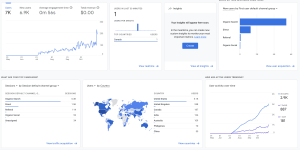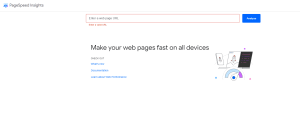
If you’re thinking that SEO for food blogs is complicated, you’re not alone. Search engine optimization is generally tough.
When it comes to Google, nothing is free! You have to work hard and use best SEO practices to rank high in search engines.
Increased ranking and more traffic are the benefits of SEO. However, SEO is more than writing high-quality content and sprinkling your keywords on it. You have to do way more than that.
At BitChip Digital, we understand the high competition food bloggers face. We have helped several food blogs with SEO, and we’re ready to offer our expertise to anyone. Just get in touch with us and we’ll take it up from there.
What Is SEO For Food Blog?
Search engine optimization (SEO) comprises the strategies used online to improve ranking and traffic to a website. It involves various techniques such as technical SEO, link building, mobile-friendliness, content creation, website page speed improvement and others.
One thing you mustn’t forget is that SEO is dynamic. Hence, we don’t advise business owners to do it by themselves. Google keeps updating its algorithm, making search engine optimization very tricky. Therefore, you must keep up-to-date with the latest SEO updates if you want to deliver best SEO practices.
At BitChip Digital, we have worked with several food bloggers, and helped them grow online.
We assist food bloggers to rank on search engines, and ensure they appear on search engine result pages for targeted keywords.
Our SEO strategy is tailored to help send more potential visitors to your food blog. We use proven search engine optimization techniques that help increase ranking, traffic and online credibility.
So, if you want to grow online using SEO strategies and experience massive growth in online traffic, we are here for you.
SEO Strategy For Your Food Blog

What are the SEO strategies you need to deploy to have a successful food blog? Here are the strategies and things you need to know.
1: Know the difference between on-site and off-site SEO.
The first thing you need to know as a food blogger is that SEO is important for your website, business and hobby. Most people run food blogs as a hobby, and if you’re in that category, you still need SEO.
When we say SEO, we’re referring to on-site and off-site optimization. Now, what do both terms mean?
On-site SEO refers to the things you do “on” your website that makes it more search engine friendly.
On the other hand, off-site SEO refers to the things you do offline that makes your food blog discoverable to search engines.
On-site or on-page SEO is 100% under your control. So let’s discuss it further to improve your understanding.
However, like we mentioned earlier, SEO is dynamic and complicated. Thus, you may need the help of a SEO specialist to outrank your competitors and that’s where we come in.
BitChip Digital offers SEO solutions to businesses of any kind. We work with small and large businesses to help them achieve success online. So your food blog will grow and become a platform to reckon with when you leave it in our care.
You can decide to handle your food blog’s optimization. We’re not against that. Being complicated doesn’t mean SEO isn’t doable. If you have the time and willingness to learn the ropes, go ahead and learn it.
2: Conduct comprehensive keyword research:

Keyword is important when it comes to optimizing your food blog for search engines. Keywords helps search engines understand the context of your content.
What are we trying to say? Before you write any content for your food blog, conduct keyword research. You must know the search volume, search intent and competitiveness of the said keyword.
There are different keyword types in search engine optimization. You can either use short-tail or the long-tail-keyword.
You can tell the difference between both keywords via their names. Short-tail keywords include a combination of one or two words “pizza,” or “pizza recipe.”
Which is better for SEO? Both keywords are better. However, it’s advisable to target long-tail keywords. Why? They are more focused search terms that visitors are most likely to use.
An example of the long-tail keyword is “best pizza recipes to prepare.” You can tell that what the person is researching about, as the keyword is explanatory.
Keywords are vital in your optimization strategy. They help search engines decipher the context of your content. That is, what your content is about and decide where it should rank in search engines.
You can use short-tail if you want. Just sprinkle a couple of them in your content, but ensure the keyword fits in naturally.
So choose the ideal keyword for your food blog. And let it be a long-tail keyword.
Understanding how to do keyword research is another important thing in SEO. You have to conduct your keyword research using a tool and know how to identify a good keyword to target.
You can use free and paid tools for keyword research. However, bear in mind that free tools won’t give you in-depth reports on keywords.
With a premium tool, the reverse is the case. You’ll have enough detail to consider when evaluating the keywords.
You must consider the search volume for each keyword and target the ones that make it easier for you to rank high on search engines.
It doesn’t matter if other food blogs are ranking for the keyword you’re targeting. If you have a sound SEO team like BitChip Digital, you can outrank your competitors in no time.
Again, finding the keyword isn’t the only thing to consider. You have other jobs to do. You have to place the keywords strategically in the content.
Here is a quick advice for you on keyword research:
- Consider the search volume of keywords before targeting them.
- Avoid highly competitive short-tail keywords if you want to have any chance of appearing on the first page of search engines for the target search term.
- Your focus should only be on long-tail keywords.
- Place your keyword in the Meta title, Meta description, alt text, and body of the content.
- Avoid keyword stuffing, an old SEO practice which will do more harm than good to your website.
What tools can you use for keyword research? There are myriads of tools out there.
- Majestic
- KWFinder
- GrowthBar
- Keyword tool
- Long-tail Pro
- SEO PowerSuite
- Moz Keyword explorer
- Google keyword planner
- Ahrefs keyword explorer
Consider the features of each keyword tool before using them. Note that while some tools provide in-depth and insightful information, others might not provide such.
At BitChip Digital, we use Ahrefs, and Long-tail Pro (premium versions) to ensure we conduct comprehensive keyword research for our clients.
A Handy Tip: When you have the keywords, place them in your content strategically.
When you target the right keyword and follow best SEO practices, you’ll increase your chances of showing up in search engine result pages.
Please note that you can use seed keyword like “pizza recipe” to get keyword ideas on AnswerThePublic. You’ll discover hundreds of topic ideas when you put the seed keyword in “AnswerThePublic.”
Again, don’t forget to consider your keyword’s competitiveness before incorporating them into your content.
3: Draft relevant recipe content
It’s a food blog, so all the content must be food-related. You can talk about recipes, dishes and more. You mustn’t deviate from what the niche embodies.
Relevant content is king, not just any content. Your content won’t rank high if the optimization strategy isn’t effective.
Your content should be top-quality and offer great value. It should solve the problems of your visitors. Note that search engines, especially Google will not hesitate to rank your site when you deliver quality content. It will only promote content that offers more value to the readers to its first page.
Before you write any content for your website or blog, ask yourself these questions:
- How much research have you done? Or, do you have enough knowledge on the topic you’re writing about?
- Is the article valuable?
- Does my content fix readers’ problems?
- Is my content readable?
- Is my content SEO-friendly?
- Is there something I need to make my content better?
In addition, endeavor to make your content 100% unique. They should be interactive and engaging. You’re writing for a food blog, so don’t forget that. You’ll have to do more practical stuff than the theory.
Finally, have you ever watched a movie or read a poorly-written book? Perhaps you felt bad because you have invested some time and had high expectations.
Your readers will feel the same way when you publish poor quality content on your food blog. So make your content worth reading. Use active voice and short paragraphs.
You’re writing content for a food blog, so illustrate with images and videos where necessary. You can even use infographics if you have the knowledge to create one.
I would like this to sink in. You’re writing for a food blog, so feel free to use images, tables and any graphical material to demonstrate your points. Show off the recipes, including how you combined them to create a meal out of nowhere.
4: Social media marketing is a game-changer:
Did you know that Facebook is the biggest social media platform globally? Interestingly, the platform records a whooping 3 billion active users every month. Anyway, don’t get carried away by Facebook’s huge active user-base.
They’re not the only ones that have the numbers in terms of users. Twitter is also doing great. And for your food blog, Instagram is a brilliant platform to showcase images of your recipes.
So, when running social media campaigns, your entire focus shouldn’t be on Facebook alone. Other social media platforms exist, so make an effort to focus on them.
However, to manage resources and get the best result, here is what you can do. Focus on social media platforms with the most audience. In other words, do you get higher engagements on Twitter, Facebook, Instagram or other popular social media apps you’re using?
You must make an effort to share content on your social media handles consistently. You can share text, videos or images of the cars you sell. But if you cannot post consistently to grow and engage your audience, don’t beat yourself. You can simply hire an expert to run your social media pages for you.
Your content should have a link directing potential customers back to your website. It’s easier for potential customers to find you this way. Just write high-quality content and make it attractive to prospects.
The various social media platforms have word limits, so ensure you convey your points within the word limit. Use images sometimes, and not only text.
5: Improve your local SEO strategy:
Local SEO is top optimization strategy that can help your food blog grow in organic traffic and ranking. Listings should be a vital part of your marketing campaign, as it drives success online.
Another thing you need to understand is local SEO, especially listings on Google My Business can have an impact on your food blog. So, consider it in your optimization plan.
Again, keep in mind that Google My Business isn’t the only platform you can place your food blog on. Below are other related platforms that can offer you similar exposure online.
Other Google My Business Alternatives:
- Yelp
- Moz local
- G2 Deals
- BrightLocal
5: Mobile-friendliness and responsive design:
One unique thing about BitChip Digital is that when we create your food website, we ensure that it’s mobile-friendly. However, if you already have a website, we’ll ensure it is mobile-friendly to enable you to hit your marketing goals online.
What does a website’s “mobile-friendliness” mean? It means the site displays properly on all devices. You won’t find it displaying half of its content on a mobile device.
Why is mobile-friendliness important? Firstly, remember that Google considers it as a ranking factor. Another reason is the number of mobile phone users and online traffic from mobile devices.
Study indicates that over 60% of people search for information, products and services online via their mobile devices. So, most of your visitors are visiting your food blog via a mobile device.
If your website isn’t mobile-friendly, its pages won’t display properly on mobile as it displays on desktop. People would have to zoom in and out to read the content or hit your CTAS.
If your website isn’t mobile-friendly, you’ll lose tons of visitors. Visitors may not remember good user experience, but won’t ever forget bad experience when they visit your website.
How do you determine your website’s mobile-friendliness? Here are the tools and techniques you can use below.
Chrome Devtools:
Devtools is a popular set of website development tools. You can check if your site is mobile-friendly with these tools.
Google PageSpeed Insight:

Google PageSpeed Insight is a free tool, owned by Google. It’s useful for testing a site’s mobile-friendliness. It also provides other information about your website performance. So, you’ll find it incredibly useful.
Mobile device:
You can determine your food blog’s mobile-friendliness via your mobile phone. You can use a smartphone or tablet for this. How is this done? It is simple. Open the browser on your phone then enter the site’s URL. If the content on the website displays fully, it’s mobile-friendly.
Here is what you’ll find out if it’s not mobile-friendly: part of the content will be cut off. Furthermore, you’ll have to scroll to the right, and the left to view some sections of the content.
Use your browser:
Here is another great and simple technique to know a site’s mobile-friendliness. In this technique, you use either browsers (Google Chrome or Firefox).
Run a Google mobile-friendly test:
This is what you have to do. Enter your URL then click on “Test URL.” The test result (your website mobile-friendliness status” will display.
Finally, what can you do if you discover your food blog isn’t mobile-friendly? If that’s the case, you need help. BitChip Digital boasts some of the finest digital marketing and SEO experts, dedicated to help businesses online.
We can help make your food blog mobile-friendly, using proven techniques and tools.
How We Make Your Website Mobile-friendly
Here are steps you can take to make your website become mobile-friendly.
- Compress images
- De-clutter web design
- Prevent pop-ups
- Optimize website speed
- Use large and readable font
- Use readable and large fonts
- Change button size and placement
- Test your site on a mobile device regularly
6: Food blog page load speed counts:
Is your food blog fast? Of course, it would be fast on your device (computer and phone). You visit now and then, so the system has stored the cache. Thus, it doesn’t need to do much to display the content on your big (desktop) and small (phone) screens.
You can only notice your website load speed when you try another device. Now the question is, how fast is your website load speed?
Understand that load speed has an impact on the following
- Search engine optimization
- Traffic
- User experience
- Conversion rate.
How fast should your website be? A study has shown that page load time of 0 to 4 seconds isn’t bad. It’s an ideal page load time to get the meaningful conversion rate.
Google wants sites to load as fast as possible within the blink of an eye. Note that Google is interested in a site’s UX.
So, even if you have irresistible recipe content (text, videos, images, infographic), a drop in conversion rate is possible if the site takes several seconds to load.
7: Backlinks aren’t obsolete:
Is backlink a wise SEO strategy? Yes and NO! Yes, if you can build a healthy link profile and no, if you’re planning to acquire links from spammy websites.
Google has made it clear that backlinks are one of its numerous ranking factors. In addition, it can help you acquire more traffic, and improve ranking.
What backlinks are relevant? Niche-specific and high authority backlinks. Google appreciates links that are natural, non-spammy and authoritative. So get backlinks, but focus on high-quality backlinks.
Quality backlinks from niche-specific sites isn’t so easy to find. Google knows this and that’s why they’re ready to reward website owners willing to work hard to get the results.
A Handy Tip: Quality matters more than quantity when it comes to link building. One high-quality backlink will have more impact than one thousand poor-quality and irrelevant backlinks.
So, build a healthy link profile. Get links from non-spammy platforms and grow your business online.
Conclusion
This SEO for food blogs exposes things you can do to grow online. Growth in this sense involves higher traffic, ranking and revenue.
The food blog niche is highly competitive. So, one must be highly creative to stand out. Now, who do you run to for digital marketing help?
Your digital marketing effort won’t pay off if you don’t hire the best agents. But help is on the way! BitChip Digital offers quality digital marketing services tailored to help your business grow.
